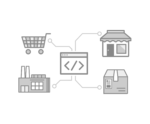Amazon is the largest online retailer by a huge margin. In fact, according to Statista,
In 2017, Amazon’s market share of the U.S. e-commerce retail market was 37 percent, and this is expected to increase significantly by 2021. As of the date of survey (October 2021) it has been projected that Amazon’s market share will account for 50 percent of the entire ecommerce retail market’s gross merchandise volume (GMV).
It makes sense just by the numbers, that working with Amazon’s customer base is a good way to grow your small business. Statista notes that Amazon uses its Prime subscription service as leverage to entice shoppers to spend more money. Prime offers free shipping, streaming movies and television shows, and other benefits. In the U.S., “as of September 2021, 65 percent of Amazon online shopping users were also subscribers to the Amazon Prime service.” Amazon Prime members are highly-engaged shoppers, whom you can learn how to sell on Amazon successfully, through its Fulfilled by Merchant (FBM) program for sellers.
What is Amazon FBM Shipping? How it Works
When you boil it down, Amazon FBM shipping is when you list your products to sell through Amazon Seller Central as part of the Prime marketplace and fulfill orders by shipping them directly to the end customer.
(Note: Amazon also has a Fulfilled by Amazon (FBA) program where Amazon stocks and ships your products.)
Amazon FBM gives the seller access to Amazon’s customers without giving up control over the logistics of the order. While the sale goes through Amazon, you have control over how, when, and how fast the product ships to the customer. However, there are some Amazon FBM shipping requirements to take note of.
Amazon FBM Shipping Requirements
Because Amazon Prime customers are such a lucrative clientele, Amazon is very picky about who has access to them. Therefore, if you want to sell through Prime and dropship to the end customer, Amazon has stringent FBM shipping requirements.
Seller Fulfilled Prime (SFP)
If you don’t meet these shipping requirements, you can still participate in FBM, but not as a Prime seller. Amazon requires a trial period before you are accepted as an SFP seller. The shipping requirements are:
- Offer premium shipping options
- Ship orders on time with a VTR rate of 99%
- Have less than 0.5% cancellation rate
- Use Amazon Buy Shipping Services for 98.5% of orders
- Use Amazon-supported SFP shippers
- Uphold the Amazon Return Policy
- Allow Amazon to handle customer service issues
You are responsible for paying for shipping to the end customer.
(Note: As of December 2021, Amazon has a waiting list to apply to be an SFP merchant.)
Standard FBM Shipping Rules
Whether or not you qualify for SFP, you still have to follow Amazon FBM shipping requirements: service-level rules. For instance, the rules for standard shipping are:
- All sellers must offer standard shipping.
- The default transit time is 4 – 15 business days.
- If you qualify for reduced shipping times, you will also have the option to select a transit time of 3 – 5 business days.
Amazon lists all their approved Prime shippers that you can use for Prime Shipping benefits. To do so, you are required to use Amazon’s Buy Shipping service. Amazon FBM shipping rates vary by weight, type of merchandise, region shipping from and to, and insurance rates.
FBM Packaging and Labeling Requirements
Amazon has strict packaging, Amazon labeling requirements, Amazon product label requirements, and Amazon barcode requirements selling via FBA, because your items will be stored and picked for shipment by Amazon. Amazon packaging guidelines are detailed for picking and shipping from their warehouses.
Amazon FBM shipping requirements: items are stored and shipped by you, so you don’t have the same requirements, but you should use best practices for shipping merchandise. The U.S. Department of Commerce has information on packaging and labeling shipments you can follow or check your shipper’s requirements.
Amazon FBM Fees
Amazon’s FBM fees are clearly stated for you, so you can calculate your total cost for using FBM. The plans are split into two main categories, individual and professional. If you are selling less than 40 items per month, you can use the individual plan. Higher volume merchants can join the professional plan. The professional plan has a monthly subscription rate, no matter how many items you sell.
Additionally, Amazon FBM has referral fees between 8% to 15% depending on the merchandise category. You are responsible for shipping fees. To better understand your shipping costs, you can use the FBM Shipping Cost Calculator, and then determine your fulfillment costs.
Pros & Cons of Amazon FBM
There are distinct pros & cons if you decide to partner with Amazon’s FBM program.
Pros
- You have control over your products, fulfillment, and costs. (The pandemic has affected the fulfillment of orders significantly.) You can determine logistics and can change them if needed.
- FBM has lower fees than FBA but still offers access to Amazon’s customer base.
- You can use your own packaging, logo, and branding, marketing your brand to new customers.
- Fulfillment is more consistent. You control fulfillment, which gives you better opportunities to adjust for any problems that crop up. (Amazon has rapidly changed requirements for FBA due to pandemic issues in 2020 and 2021.)
- Outsourcing by dropshipping to the end customer may give you better communication and relationship with the fulfillment company.
- Potentially launch new products faster because you control final approval.
Cons
- You lose the Prime badge unless you participate in SFP.
- You will have more marketing costs if you lose the Prime badge.
- Your control over fulfillment means that you also have the sole responsibility for any fulfillment problems.
- Costs associated with FMB may be higher than FBA, especially for warehousing and shipping.
- More time is spent on orders with outsourcing to third-party fulfillment companies.
How Can Ordoro Help?
Ordoro can make the FBM process easier for Amazon sellers from beginning to end. Ordoro breaks down the vast amount of information on Amazon Seller Central and helps you digest it in smaller, more manageable chunks while giving you the technical support needed for FBM and/or SFP.
Ordoro gives you the ability to smoothly integrate your business with Amazon’s interface.
- Automatically track and sync your in-house inventory, and set up Automation Rules and Shipping Presets to accelerate your workflow.
- Ordoro’s discounted shipping rates of up to 67% via USPS have you covered.
- Identify your top-selling products with Ordoro’s Analytics dashboard.
- Use Ordoro’s Supplier Feeds to connect directly to them for real-time updates.
- Link dropshipped SKUs to their vendors within Ordoro to manage shipping.
- Set up a Vendor Portal with Ordoro that allows vendors to fulfill orders on their own.
- Prioritize your SFP orders within Ordoro, and identify any delayed shipments.
- Minimize risk of fulfillment errors with Ordoro’s Barcode Scanner.
- Automatically retrieve the tracking ID for every shipped order and send it to your customer.
Unlike other shipping and inventory management systems, Ordoro DOES NOT charge extra fees on Amazon Prime orders.
Ordoro Easy Inventory Management and Order Processing Software for Amazon FBM
Ordoro makes working with Amazon FBM easier because it is an all-in-one software solution in regards to shipping, automation, inventory, dropshipping, and more. Ordoro provides valuable resources to learn how to sell on Amazon for beginners using these tools.
- Amazon Fulfillment Guide
- Amazon Dropshipping: Pros & Cons
- Support articles
- What are Amazon ghost listings and how can I address them?
- Can I filter my products by Amazon Fulfillment type?
- When and how do I update the Amazon Fulfillment Channel status (FBM or FBA) in Ordoro?
- Does Amazon Seller Fulfilled Prime (Buy Shipping) work with Supplier portals?
- How do I use Amazon Seller Fulfilled Prime to ship my Amazon Prime orders?
Have Questions About Amazon FBM?
Ordoro can help you find answers. Schedule your demo for more information.


